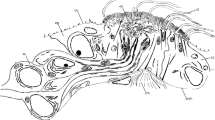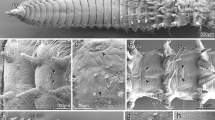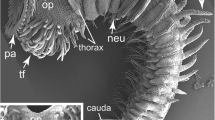Abstract
The reef-building sedentary polychaete, Sabellaria alveolata, is well known for its specialized anterior end, the operculum, which is exposed to the environment during vital activities, such as feeding or as it seals its tube when the animal withdraws. This region represents the most important sensory structure in Sabellariidae. It comprises two lobes, tentacular filaments, protective chaetae (paleae), a median organ, and a median ridge, and bears various pigmented spots. Worms swiftly withdraw into tubes triggered by abrupt light change (shadow reflex). We suspected that the pigmented spots were photoreceptive and responsible for the shadow response. To test this hypothesis, the median organ and median ridge of S. alveolata were investigated by applying light microscopy, confocal laser scanning microscopy, scanning, and transmission electron microscopy. Besides unciliated supportive cells, these organs consist of numerous multiciliated and glandular cells on their ventral surfaces. The multiciliated cells are of two types: epidermal supportive and receptor cells. The median organ is innervated directly from the brain by two longitudinal basiepithelial nerves. The presence of multiciliated cells and mucocytes suggests that the organ is sensory, involved in both feeding and tube-building behavior. Furthermore, we found two pairs of eyespots on the lateral posterior part of the median ridge, situated close to the neurite bundles anterior to the brain. These eyes are simple in structure and resemble larval-type eyes. They are composed of only two cells each, one rhabdomeric photoreceptor cell and one pigmented supportive cell. The pigmented eyes on the median ridge are clearly involved in photoreception and very likely involved in shadow reflex.
Similar content being viewed by others
References
Amieva MR, Reed CG (1987) Functional morphology of the larval tentacles of Phragmatopoma californica (Polychaeta: Sabellaridae): composite larval and adult organs of multifunctional significance. Mar Biol 95:243–258
Amieva MR, Reed CG, Pawlik JR (1987) Ultrastructure and behavior of the larva of Phragmatopoma californica (Polychaeta: Sabellariidae): identification of sensory organs potentially involved in substrate selection. Mar Biol 95:59–266
Arendt D, Hausen H, Purschke G (2009) The ‘division of labour’ model of eye evolution. Philos Trans R Soc B 364:2809–2817
Aviz D, Pinto AJA, Ferreira MAP, Rocha A, Rosa Filho JS (2018) Reproductive biology of Sabellaria wilsoni (Sabellariidae: Polychaeta), an important ecosystem engineer on the Amazon coast. J Mar Biol Assoc UK 98:743–754
Ayers T, Tsukamoto H, Gühmann M, Rajan VBV, Tessmar-Raible K (2018) A Go-type opsin mediates the shadow reflex in the annelid Platynereis dumerilii. BMC Biol 16:41
Bok MJ, Nilsson D-E (2016) Fan worm eyes. Curr Biol 26:R907–R908
Bok MJ, Capa M, Nilsson D-E (2016) Here, there and everywhere: the radiolar eyes of fan worms (Annelida, Sabellidae). Integr Comp Biol 56:784–795
Bok MJ, Porter ML, Nilsson D-E (2017) Phototransduction in fan worm radiolar eyes. Curr Biol 27:R681–R701
Capa M, Hutchings P (2014) Sabellariidae Johnston, 1865. In: Westheide W, Purschke G, Böggemann M (eds) Handbook of zoology online. A natural history of the phyla of the animal kingdom; Annelida: Polychaetes. De Gruyter, Berlin. http://www.degruyter.com/view/db/zoology/bp_029147-6_63. Accessed 15 Oct 2014
Capa M, Hutchings P, Peart R (2012) Systematic revision of Sabellariidae (Polychaeta) and their relationship with other polychaetes using morphological and DNA sequence data. Zool J Linn Soc 164:245–284
Capa M, Faroni-Perez L, Hutchings P (2015) Sabellariidae from Lizard Island, Great Barrier Reef, including a new species of Lygdamis and notes on external morphology of the median organ. Zootaxa 4019:184–206
Culloty SC, Favier E, Ní Riada M, Ramsay NF, O’Riordan RM (2010) Reproduction of the biogenic reef-forming honeycomb worm Sabellaria alveolata in Ireland. J Mar Biol Assoc UK 90:503–507
Dales RP (1952) The development and structure of the anterior region of the body in the Sabellariidae, with special reference to Phragmatopoma californica. Q J Microsc Sci 93:435–452
Dubois S, Barillé L, Cognie B, Beninger PG (2005) Particle capture and processing mechanisms in Sabellaria alveolata (Polychaeta: Sabellariidae). Mar Ecol Prog Ser 301:159–171
Dubois S, Comtet T, Retière C, Thiébaut E (2007) Distribution and retention of Sabellaria alveolata larvae (Polychaeta: Sabellariidae) in the bay of Mont-Saint-Michel, France. Mar Ecol Prog Ser 346:243–254
Eckelbarger KJ (1976) Larval development and population aspects of the reef-building polychaete Phragmatopoma lapidosa from the east coast of Florida. Bull Mar Sci 26:117–132
Eckelbarger KJ (1977) Larval development of Sabellaria floridensis from Florida and Phragmatopoma californica from southern California (Polychaeta: Sabellariidae), with a key to the sabellariid larvae of Florida and a review of development in the family. Bull Mar Sci 27:241–255
Eckelbarger KJ (1978) Metamorphosis and settlement in the Sabellariidae. In: Chia F-S, Rice ME (eds) Settlement and metamorphosis of marine invertebrate larvae. Elsevier, New York, pp 145–164
Eckelbarger KJ, Chia FS (1976) Scanning electron microscopic observations of the larval development of the reef-building polychaete Phragmatopoma lapidosa. Can J Zool 54:2082–2088
Ermak TH, Eakin RM (1976) Fine structure of the cerebral and pygidial ocelli in Chone ecaudata (Polychaeta: Sabellidae). J Ultrastruct Res 54:243–260
Faroni-Perez L (2014) Seasonal variation in recruitment of Phragmatopoma caudata (Polychaeta: Sabellariidae) in the southeast coast of Brazil: validation of methodology for categorizing age classes. Iheringia 104:5–13
Faroni-Perez L, Helm C, Burghardt I, Hutchings P, Capa M (2016) Anterior sensory organs in Sabellariidae (Annelida). Invertebr Biol 135(4):423–447
Hausen H (2001) Untersuchungen zur Phylogenie “spiomorpher” Polychaeten (Annelida). Logos, Berlin, pp 1–142
Hausen H (2005) Comparative structure of the epidermis in polychaetes (Annelida). Hydrobiologia 535/536:25–35
Helm C, Bok MJ, Hutchings P, Kupriyanova E, Capa M (2018) Developmental studies provide new insights into the evolution of sense organs in Sabellariidae (Annelida). BMC Biology 18:149. https://doi.org/10.1186/s12862-018-1263-5
Horridge GA (1963) Proprioceptors, bristle receptors, efferent sensory impulses, neurofibrils and number of axons in the parapodial nerve of the polychaete Harmothoe. Proc R Soc Lond Ser B 157:199–222
Jékely G, Colombelli J, Hausen H, Guy K, Stelzer E, Nédélec F, Arendt D (2008) Mechanism of phototaxis in marine zooplankton. Nature 456:395–399
Kirtley DW (1994) A review and taxonomic revision of the family Sabellariidae Johnston, 1865 (Annelida; Polychaeta) (series 1). Sabecon Press Science, Los Angeles, pp 1–223
Kristensen RM, Nørrevang A (1982) Description of Psammodrilus aedificator sp.n. (Polychaeta), with notes on the Arctic interstitial fauna of Disko Island, W. Greenland. Zool Scr 11:265–279
Lacalli T (2018) Amphioxus, motion detection, and the evolutionary origin of the vertebrate retinotectal map. EvoDevo 9:6. https://doi.org/10.1186/s13227-018-0093-2
Lawry JV Jr (1967) Structure and function of the parapodial cirri of the polynoid polychaete, Harmothoe. Zeitschrift für Zellforschung und Mikroskopische Anatomie 82:345–361
Lechapt JP, Kirtley DW (1996) Bathysabellaria spinifera (Polychaeta: Sabellariidae), a new species from deep water off New Caledonia, Southwest Pacific Ocean. Proc Biol Soc Wash 109:560–574
Lehmacher C, Ramey-Balci PA, Wolff LI, Fiege D, Purschke G (2016) Ultrastructural differences in presumed photoreceptive organs and molecular data as a means for species discrimination in Polygordius (Annelida, Protodriliformia, Polygordiidae). Org Divers Evol 16:559–576
Martínez A, Purschke G, Worsaae K (2017) Protodrilidae Hatschek, 1888. In: Westheide W, Purschke G, Böggemann M (eds) Handbook of zoology online. A natural history of the phyla of the animal kingdom; Annelida: Polychaetes. http://www.degruyter.com/view/Zoology/pb029147-6_8. Accessed 19 Sept 2017
McCarthy DA, Forward RB Jr, Young CM (2002) Ontogeny of phototaxis and geotaxis during larval development of the sabellariid polychaete Phragmatopoma lapidosa. Mar Ecol Prog Ser 241:215–220
Nicol JAC (1950) Responses of Branchiomma vesiculosum (Montagu) to photic stimulation. J Mar Biol Assoc UK 29:303–320
Nilsson DE (1994) Eyes as optical alarm systems in fan worms and ark clams. Philos Trans R Soc Lond B 346:195–212
Orrhage L (1978) On the structure and evolution of the anterior end of the Sabellariidae (Polychaeta, Sedentaria). With some remarks on the general organisation of the polychaete brain. Zool Jb Anat 100:343–374
Pawlik JR (1986) Chemical induction of larval settlement and metamorphosis in the reef building tube worm Phragmatopoma californica (Polychaeta: Sabellariidae). Mar Biol 91:59–68
Pawlik JR (1988) Larval settlement and metamorphosis of two gregarious sabellariid polychaetes: Sabellaria alveolata compared with Phragmatopoma californica. J Mar Biol Assoc UK 68:101–124
Pawlik JR (1990) Natural and artificial induction of metamorphosis of Phragmatopoma lapidosa californica (Polychaeta: Sabellariidae), with a critical look at the effects of bioactive compounds on marine invertebrate larvae. Bull Mar Sci 46:512–536
Pergner J, Kozmik Z (2017) Photoreceptors of amphioxus—insights into evolution of vertebrate opsins, vision and circadian rhythmicity. Int J Dev Biol 61:665–681. https://doi.org/10.1387/ijdb.170230zk
Purschke G (2011) Sipunculid-like ocellar tubes in a polychaete, Fauveliopsis cf. adriatica (Annelida, Fauveliopsidae): implications for eye evolution. Invertebr Biol 130:115–128
Purschke G (2016) Annelida: basal groups and pleistoannelida. In: Schmidt-Rhaesa A, Harzsch S, Purschke G (eds) Structure and evolution of invertebrate nervous systems. Oxford University Press, Oxford, pp 254–312
Purschke G, Müller MC (1996) Structure of photoreceptor-like sense organs in Protodriloides species (Polychaeta, Protodrilida). Cah Biol Mar 37:205–219
Purschke G, Nowak K (2015) Ultrastructure of pigmented eyes in Dorvilleidae (Annelida, Errantia, Eunicida) and their importance for understanding the evolution of eyes in polychaetes. Acta Zool 96:67–81
Purschke G, Arendt D, Hausen H, Müller MCM (2006) Photoreceptor cells and eyes in Annelida. Arthropod Struct Dev 35:211–230
Purschke G, Bleidorn C, Struck T (2014) Systematics, evolution and phylogeny of Annelida—a morphological perspective. Mem Mus Vic 71:247–269
Purschke G, Hugenschütt M, Ohlmeyer L, Meyer H, Weihrauch D (2017) Structural analysis of the branchiae and dorsal cirri in Eurythoe complanata (Annelida, Amphinomida). Zoomorphology 136:1–18
Randel N, Jékely G (2015) Phototaxis and the origin of visual eyes. Philos Trans R Soc 371:1–12
Richter S, Loesel R, Purschke G, Schmidt-Rhaesa A, Scholtz G, Stach T, Vogt L, Wanninger A, Brenneis G, Döring C, Faller S, Fritsch M, Grobe P, Heuer CM, Kaul S, Møller OS, Müller CHG, Rieger V, Rothe BH, Stegner MEJ, Harzsch S (2010) Invertebrate neurophylogeny: suggested terms and definitions for a neuroanatomical glossary. Front Zool 7:29
Riisgrad HU, Nielsen C (2006) Feeding mechanism of the polychaete Sabellaria alveolata revisited: comment on Dubois et al. (2005). Mar Ecol Prog Ser 328:295–305
Rouse GW, Pleijel F (2001) Polychaetes. Oxford University Press, New York, 345 pp
Smith PR, Chia F-S (1985) Larval development and metamorphosis of Sabellaria cementarium Moore, 1906 (Polychaeta: Sabellariidae). Can J Zool 63:1037–1049
Struck TH, Golombek A, Weigert A, Franke FA, Westheide W, Purschke G, Bleidorn C, Halanych KM (2015) The evolution of annelids reveals two adaptive routes to the interstitial realm. Curr Biol 25:1993–1999
Vodopyanov S, Purschke G (2017) Fine structure of the cerebral eyes in Flabelligera affinis (Annelida, Sedentaria, Cirratuliformia): new data prove the existence of typical converse annelid multicellular eyes in a sedentary polychaete. Zoomorphology 136:307–325
Weigert A, Bleidorn C (2016) Current status of annelid phylogeny. Org Divers Evol 16:345–362
Wilkens V, Purschke G (2009) Pigmented eyes, photoreceptor-like sense organs and central nervous system in the polychaete Scoloplos armiger (Orbiniidae, Annelida) and their phylogenetic importance. J Morphol 270:1–15
Wilson DP (1929) The larvae of the British sabellarians. J Mar Biol Assoc UK 15:221–269
Wilson DP (1968) The settlement behaviour of the larvae of Sabellaria alveolata (L.). J Mar Biol Assoc UK 48:387–435
Wilson DP (1977) The distribution, development and settlement of the sabellarian polychaete Lygdamis muratus (Allen) near plymouth. J Mar Biol Assoc UK 57:761–792
Acknowledgements
We are grateful to the head of our department, Professor Dr. A. Paululat, Osnabrück, for various kinds of support. Professor Dr. T. Bartolomaeus and Dr. E. Tilic, Bonn, Germany, kindly helped fixing specimens from Mont St. Michel. Thanks are also due to K. Etzold and W. Mangerich, Osnabrück, for various kinds of technical assistance, particularly for introducing CM to electron microscopy techniques. Funding was provided by National Council for Scientific and Technological Development, Brazil (CNPq – SWE 201233/2015-0) and Muséum National d’Histoire Naturelle.
Note added in proof
While this paper was in type setting another study on a sabbellariid median organ was published (Helm et al. 2018): The authors regard the median organ as a structure comparable to nuchal organs and describe the eyes of Idanthyrsus australensis differing in structure, number and position from those described here for S. alveolata.
Author information
Authors and Affiliations
Corresponding author
Ethics declarations
Conflict of interest
The authors declare that they have no conflict of interest.
Ethical standard
We neither used endangered species nor were the investigated animals collected in protected areas. All applicable international, national, and/or institutional guidelines for the care and use of animals were followed.
Electronic supplementary material
Below is the link to the electronic supplementary material.
Supplementary material 1 (MP4 61832 KB)
Rights and permissions
About this article
Cite this article
Meyer, C., Faroni-Perez, L. & Purschke, G. Anterior sense organs in Sabellaria alveolata (Annelida, Sedentaria, Spionida) with special reference to ultrastructure of photoreceptor elements presumably involved in shadow reflex. Zoomorphology 138, 39–54 (2019). https://doi.org/10.1007/s00435-018-0422-y
Received:
Revised:
Accepted:
Published:
Issue Date:
DOI: https://doi.org/10.1007/s00435-018-0422-y











